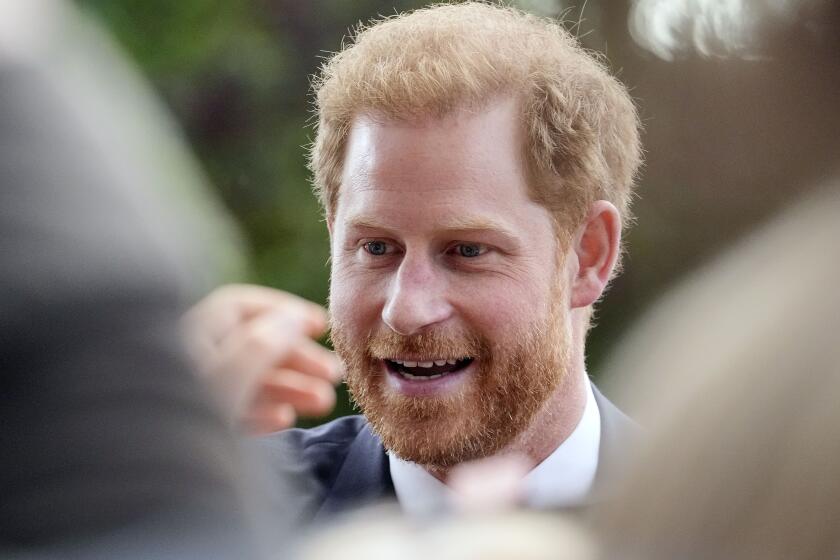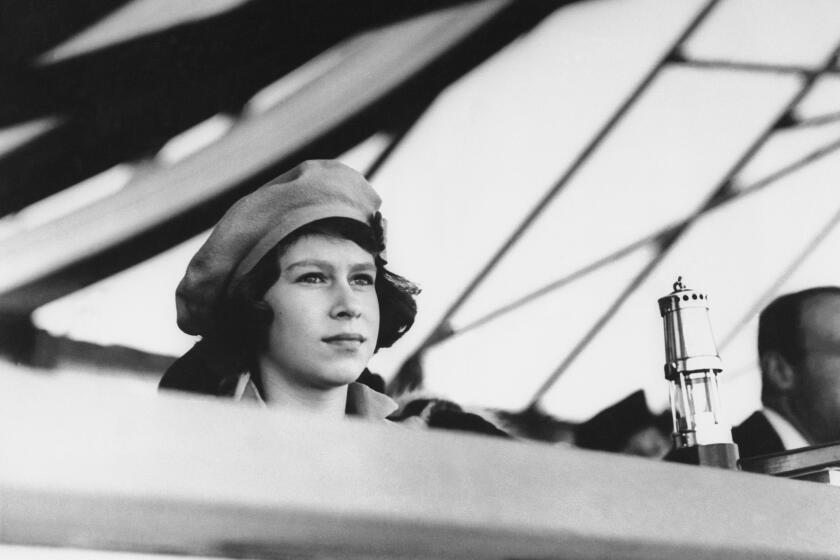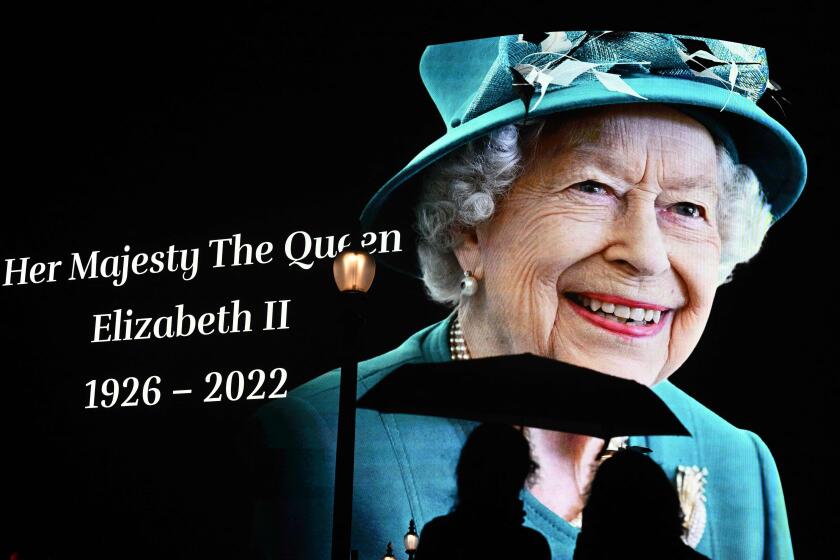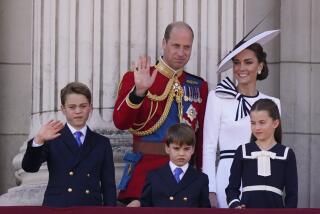Queen Elizabeth II’s coffin leaves Buckingham Palace to lie in state till her funeral
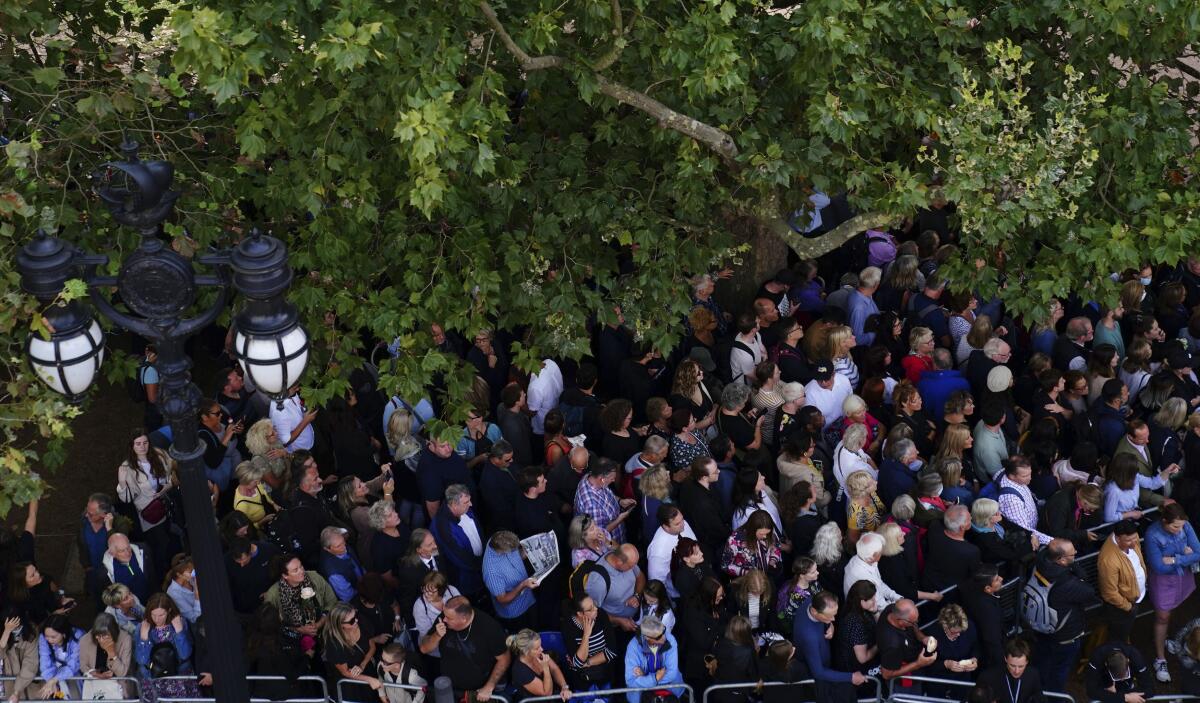
- Share via
LONDON — Queen Elizabeth II left Buckingham Palace for the last time Wednesday, her coffin borne to the Houses of Parliament by a horse-drawn gun carriage and trailed by grieving family members, including new King Charles III.
The coffin will lie in state until the late monarch’s funeral Monday, with hundreds of thousands of people expected to file past. Eight pallbearers carried the oak and lead-lined coffin into Westminster Hall, placing it on a raised platform known as a catafalque.
With the Royal Standard and crown of state resting on top of the coffin and artillery firing salutes at one-minute intervals, the solemn procession from Buckingham Palace was designed to underscore the queen’s seven decades as head of state as the national mourning process shifted to the grand boulevards and historic landmarks of the British capital.
Charles and his sons, Princes William and Harry, and other members of the royal family walked behind the gun carriage.
Thousands of people who had waited for hours along the Mall outside the palace and other locations to line the route held up phones and cameras, and some wiped away tears, as the procession passed. Applause broke out as it went through Horse Guards Parade.
The coffin was draped in the Royal Standard and topped with the Imperial State Crown — which is adorned with almost 3,000 diamonds — and a bouquet of flowers and plants including pine from the Balmoral Estate in Scotland, where Elizabeth died last week.
‘Her unwavering grace and dignity remained true throughout her life and now her everlasting legacy,’ Prince Harry said after the death of the queen.
An escort of two officers and 32 troops from the 1st Battalion Grenadier Guards in red uniforms and bearskin hats walked on either side of the gun carriage. Big Ben tolled, a gun salute boomed from Hyde Park and the martial strains of a military band accompanied the procession.
The 38-minute procession ended at Westminster Hall, where Archbishop of Canterbury Justin Welby led a service attended by Charles and other royals after the coffin was brought in. The choir of Westminster Abbey and the Choir of His Majesty’s Chapel Royal sang the words of a psalm.
“Let not your heart be troubled: ye believe in God, believe also in me. In my Father’s house are many mansions: if it were not so, I would have told you,” Welby said as he read from the Gospel of John.
Thousands of people were standing or sitting in line along the banks of the River Thames waiting their turn to file past the coffin and pay their respects.
From her ambulance service during World War II to being the subject of a Beatles song, Queen Elizabeth II lived a remarkable, and long, life.
The crowds are the latest manifestation of a nationwide outpouring of grief and respect for the only monarch most Britons have ever known, who died Thursday at age 96, ending a 70-year reign.
Joan Bucklehurst, a 50-year-old retail worker from Cheshire in northwestern England, said the queen “meant so much for everybody.”
“She was amazing,” Bucklehurst said, choking up with emotion. “So we had to be here. We’ve been here a few times when there have been special occasions, but this one, I couldn’t miss this.”
“It’s a very sad day, but it’s our last opportunity to do our duty for the queen and it’s our first opportunity to do it for the king, and that makes us all very proud,” said Maj. Gen. Christopher Ghika of the Household Division, who is responsible for organizing the ceremonial aspects of the queen’s funeral.
In India, emotions over Queen Elizabeth II’s passing ran the gamut, from sympathy to calls for the return of the Kohinoor diamond.
London’s Heathrow Airport halted flights to prevent overhead planes disturbing the procession.
Troops involved in the procession have been preparing since the queen died. So have the horses of the King’s Troop Royal Horse Artillery.
Sgt. Tom Jenks of the artillery said that the horses have undergone special training, including how to handle weeping mourners, as well as flowers and flags being thrown onto streets as the procession passes by.
Since the early morning, people staked out prime viewing positions behind metal barriers along the Mall and other streets along the route. They stood or sat on folding chairs, umbrellas at the ready, takeout coffees in hand.
Start your day right
Sign up for Essential California for the L.A. Times biggest news, features and recommendations in your inbox six days a week.
You may occasionally receive promotional content from the Los Angeles Times.
Crowds have lined the route of the queen’s coffin whenever it has been moved in its long journey from Scotland down to London.
On Tuesday night, thousands braved a typical London drizzle as the state hearse, with interior lights illuminating the sovereign’s flag-draped casket, drove slowly from a military air base into the heart of the British capital.
Geoff Colgan, a taxi driver who took the day off to witness the moment, stood stunned in the moments after the queen’s coffin passed.
“It’s one of those things you know would happen, but when it does you can’t believe it,” he said, holding his toddler.
Earlier, in Edinburgh, the Scottish capital, some 33,000 people filed in silent respect past her coffin as it lay for 24 hours at St. Giles’ Cathedral. Hundreds of thousands are expected to do the same in London when the queen lies in state in the 900-year-old Westminster Hall, the oldest building in Parliament, until her state funeral Monday.
The hall is where medieval kings and queens hosted magnificent banquets, where King Charles I was tried in the 17th century (he was later beheaded) and where ceremonial addresses were delivered to Queen Elizabeth II during her silver, golden and diamond jubilees.
More to Read
Sign up for Essential California
The most important California stories and recommendations in your inbox every morning.
You may occasionally receive promotional content from the Los Angeles Times.
